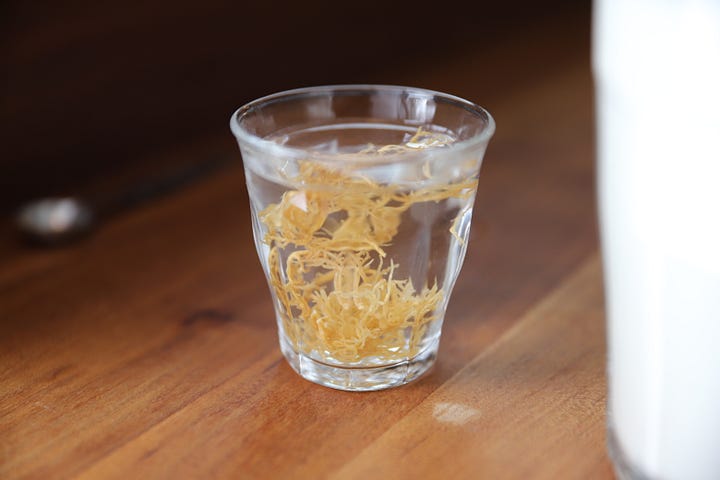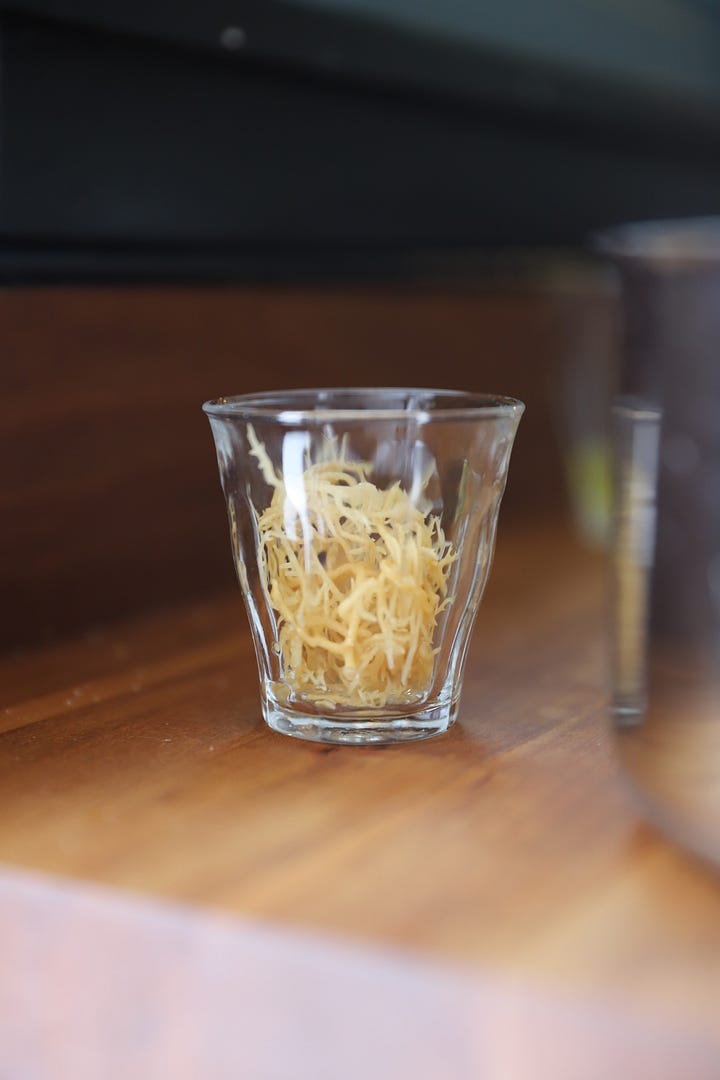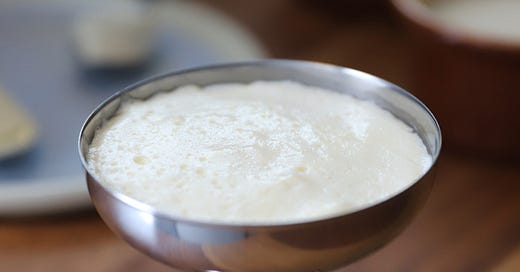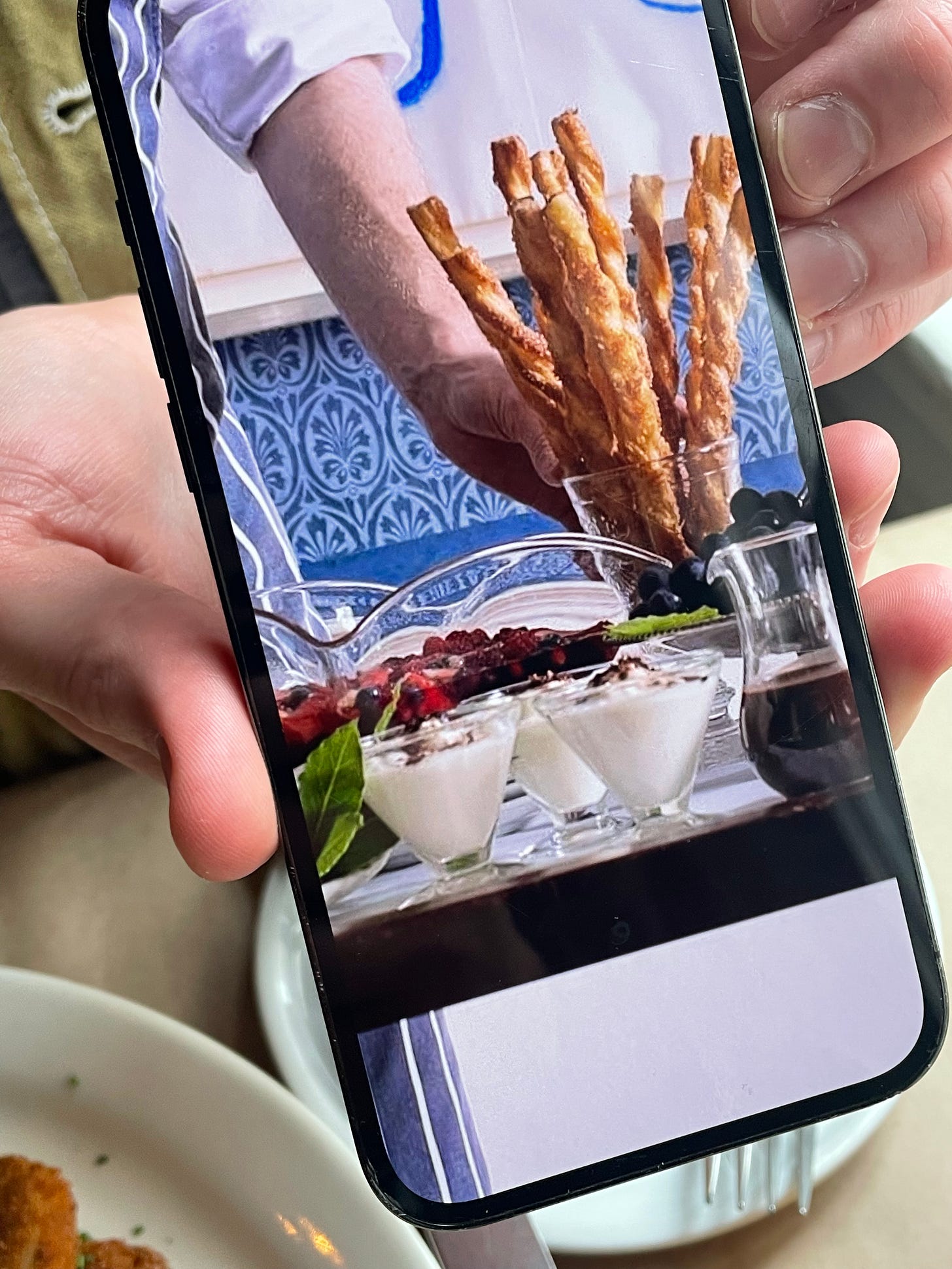Good morning,
I finally put to use the packet of Irish moss, a type of seaweed about which you can read plenty below, that I’d ordered (from Amazon, still the only place I can say you’ll easily find it, sadly) nearly two years ago.
Also known as carrageen, it’s fascinating stuff. In addition to scouring digitized books and old newspapers, I asked a few Irish people, including seaweed evangelist Prannie Rhatigan, pastry chef JR Ryall, food writer
, and my literary agent, Sharon Bowers, about its role in Irish life. I’ll share what I learned, including what carrageen pudding is, some history of the dessert, and how it’s made; what exactly carrageen (Irish moss) is, Ireland and its connection to seaweed; the history and uses of carrageen; how carrageen is harvested; and how carrageen sets a pudding. I also detail the experiment I did to test the function of carrageen and the other main components of the pudding.I include the recipe for carrageen pudding at the end of all this, but if you’d like to jump ahead to it (or if you don’t have a paid subscription to Formal Assignment), you can see the recipe here.
Also, some recommendations:
I don’t know if an episode of the podcast Heavyweight has ever disappointed me, but it would be unreasonable to expect all of its stories to be as shocking and riveting as the one of Barbara Schutt, which unfolds over the course of two episodes (ep. 40, followed by ep. 41). If you haven’t listened to Heavyweight before, you’re lucky to have the entire archive to peruse. New episodes haven’t been produced since 2023, but it was recently announced that the podcast has found a new production company and will have new audio stories for us soon.
Another podcast, Celebrity Book Club, recently lost its contract with iHeart. Hosts Steven and Lily, who usually dissect celebrity memoirs in a hilarious and intelligent manner, use their final recording session in an iHeart studio to tell the maddening story of why their days with that production company have come to an end. (Another two-part episode: 1 and 2)
Talk to you soon. I you enjoy reading about carrageen and carrageen pudding as much as I enjoyed researching them. Thanks for reading this.
Brian
*Formal Assignment P.S. is for paid subscribers. It’s just $6 a month—or even less for an annual subscription. 🎁 Did you know you can gift a F.A. subscription to a beloved? You can! Right here!
---
ALL ABOUT CARRAGEEN PUDDING
---
What’s Carrageen Pudding?
Carrageen pudding, like its namesake ingredient, goes by a few names that also include Irish moss pudding, carageen moss pudding, and carrageen blanc-mange. It could just as accurately be called Irish seaweed pudding. Like panna cotta, carrageen pudding falls into the category of blanc-mange-descended wobbly set-milk desserts. Like a panna cotta, this pudding can be flavored with anything imaginable but is most often kept simple with flavor from a dash of vanilla, subtle sweetness from a bit of sugar, and both richness and lightness from a (separated) egg. The notable element that differentiates carrageen pudding from similar desserts is the gelling agent that transforms it from liquid to semi-solid: seaweed—specifically, two species of seaweed commonly called carrageen that are historically plentiful and harvested along the rocky Irish coast.
Some History:
While the precise origin of carrageen pudding is unknown—no great chef is said to have invented it, no royal patron is credited with inspiring it—it likely developed as a vernacular dish that made use of a freely available ingredient long valued for its salubrious effects. In print, the recipe made some early appearances in such books as Vegetable Cookery ; with an Introduction Recommending Abstinence from Animal Food and Intoxicating Liquors, mysteriously authored by “A Lady” in the UK in 1833[i]. A recipe in Directions for Cookery, in Its Various Branches is evidence that the idea had made its way to the United States by 1844; and a recipe by Mary A. Boland, “Instructor in Cooking in the Johns Hopkins Hospital Training-School for Nurses”, in A Handbook of Invalid Cooking from 1906 demonstrates the pudding recipe’s staying power in the U.S., at least among some health-minded American writers, through the turn of the century.
Although it’s deeply and undeniably rooted in Ireland, carrageen pudding is not a ubiquitous offering across the Emerald Isle of the twenty-first century; journalist Chris Bananiuk writes, “Despite growing up in Northern Ireland, I had never heard of this dessert. I asked a few friends but they, too, were oblivious.”
But, while every Irish person may not make it, regularly eat it, or even know of it, the dish is alive and well, thanks in part to Irish chefs and cookbook authors who endeavor to keep it that way. “As carraigín [the Irish spelling] transcends centuries and is so steeped in folklore and memories,” writes Prannie Rhatigan, author of Irish Seaweed Kitchen, “it is fitting that some of the most respected chefs in Ireland keep it firmly in their repertoire as a special treat on their desserts trolley.”[ii]
About the Recipe:
I can’t imagine a better segue to introducing JR Ryall, the pastry chef at Ballymaloe—a restaurant bundled up with a farm, cookery school, and inn—in East Cork, Ireland. Of the six offerings that appear daily on his restaurant’s dessert trolley, only one remains constant: Mrs Allen’s carrageen moss pudding, named for Ballymaloe’s founder, Myrtle. “Not only do I love the dessert,” Ryall told Nicola Lamb in 2022, “I love the process. I love that [Mrs Allen] taught me how to make it. It’s frugal,” made of just a few simple ingredients. Milk, simmered with carrageen, is added to a humble heap of sugar, a tiny proportion of egg yolk, and vanilla extract. Finally, a whipped egg white is gently folded in to lighten the pudding and to create a superficial foam that, as Ryall told me in admittedly floral language, “emulates that foam on the sea where it meets the rocks.” Frugal though it may be, the dessert is delicious. As Ryall explains in his book, Ballymaloe Desserts, this “recipe yields a silky and delicate dessert, with the most pleasing texture I know, and this texture is key to the enjoyment of the dish. When the balance is right the pudding is transcendent. The trick here, though, is to use just enough carrageen moss for the milk to have a soft set and a gentle flavour. Use too much and the dish will be firm, less sophisticated and have too strong a ‘seaweed’ flavour.”
When Ryall and I met for lunch recently—the very day after I’d made carrageen pudding for the first time—he told me with apparent pride that he cooks like a granny, because he in fact learned to cook from grannies: Mrs Allen and her daughter-in-law, Darina. He told Evan Kleiman on KCRW’s Good Food the paradoxical unconventionality of doing things the “granny” way in a professional setting when Mrs Allen started out: “Mrs Allen always set great value on traditional Irish dishes. And when she opened the restaurant, she took great pride in serving these vernacular things, but elevating them..[T]he idea of having a folk food in a restaurant would have been quite revolutionary in the 1960s in Ireland”—as opposed to today, when “there’s great appreciation for these foraged foods and…unusual delicacies.”
ALL ABOUT CARRAGEEN
What’s Carrageen?
Carrageen, or Irish moss, writes Rhatigan, is the common name for two species of seaweed (Chondrus crispus and Mastocarpus stellatus) harvested for various culinary and homeopathic applications. It can be found growing “all over the Irish coast, in rocky places”—"carraigín” means “little rock” in Irish—"and estuaries. But it is distributed around the world, growing in similar habitats in much of Europe, Canada, the United States, and parts of Asia.” Rhatigan describes carrageen as a “Small bushy fan-shaped seaweed with flat fronds”, seven to fifteen centimeters in height, with “Colours [that] range from pink to dark purple to cream”, often with “a beautiful violet iridescence which is lost when the plants are harvested.” Indeed, the dried Irish moss I bought is far in appearance from the Rhatigan’s enchanting description of the living algae: it’s a dull strawberry-blond mass that resembles thick, tangled wool.


Ireland and Its Seaweed:
As Ryall points out in his book, “Ireland is not the first country that springs to mind when one thinks of cultures associated with consuming seaweed,” but there exists in fact a deep-seated connection to algae on the island that goes beyond carrageen. Journalist and cookbook author
writes that “Seaweed once held an esteemed position in Irish culinary, medical, and agricultural traditions. Packed with healthful nutrients and minerals, it was appreciated for its texture and briny flavor in dishes [and its gelling power!], its rejuvenating properties in lotions and bath salts, and the fertilizing wonders it worked in the garden.”Sharon Bowers, my literary agent who has lived in the Dublin area for decades, told me that her mother-in-law “used to pick up pieces of dillisk [dulse] while walking on the beach and chew on them.” (Laura Brehaut writes that the fresh dulse she harvested during a trip to Ireland “blew me away by its intensity; it’s been referred to as the ‘truffle of the sea’ due to its rich umami flavour.” Side note: umami is essentially seaweed flavor; in 1908, Japanese chemist Ikeda Kikunae isolated the flavorful substance in kombu, a type of sea kelp, that would come to be known as monosodium glutamate (MSG) and coined the term “umami” to describe its unique taste.[iii]) Seaweed baths are also enjoyed in Ireland. Sharon told me, “When I’m in Co. Sligo, I make a point…of going for a bath at the Killcullen Seaweed Baths in Enniscrone. You soak in huge old enamel tubs full of hot seawater and seaweed, and you rub it all over yourself and your skin comes out silky like [you’ve used] bath oil. And then you heft all the clumps of seaweed into a bucket standing nearby, drain the tub (it literally runs right back into the ocean) stand up, and pull a brass chain that makes icy cold seawater pour down on your head. I suspect this doesn’t sound appealing but…it’s so great!”
History and Uses of Carrageen:
Let’s re-focus on carrageen and its history and uses. As for the word itself, Rhatigan tells us that “The name ‘carrageen’ was introduced around 1830 and probably came from Carrigan Head in Co. Donegal in north-western Ireland.” In those days, “coastal dwellers…harvested feverishly during the equinox spring tides, so the crop could be spread to dry and bleach in the March winds and rain and be ready for sale a few weeks later.” To whom did they sell? “The main buyers were French cosmetic and pharmaceutical firms who used the carraigín for gels and cough mixtures, and London breweries that used it to purify beer.” Back home in Donegal, it “was fed to calves during lean times to supplement their diets, and during the years of the great potato famine, 1846-49, carraigín is said to be one of the three plants that kept many from total starvation, the other two being charlock and nettle.” A 1943 article in the Journal of the Royal Society of Arts claims that during World War I, “carrageen was in demand to replace gelatin which was in short supply. The Red Cross issued a pamphlet figuring the two seaweeds…and giving instructions for the collecting and washing and drying of the algae…”[iv]
Harvesting Carrageen:
The instructions in the Red Cross pamphlet wouldn’t have differed much from how Ryall, Rhatigan, and other enthusiasts go about their harvest and processing. Rhatigan writes that the traditional time to collect carrageen was “in spring at the high tides of Shrove Tuesday and St Patrick’s Day, but usually harvest in Ireland [occurs] now during the summer months and into early autumn.” Rhatigan advises to cut with scissors, leaving the base of the seaweed in place on its home rock so that it can continue to live and regenerate. “After it is picked,” Ryall writes, “the seaweed must be sorted, cleaned and dried: First it is washed in fresh cold water and any tangled weeds, foreign objects or creatures are removed. Next the moss is laid out on the cliff tops or a patch of grass in a sunny spot. The seaweed naturally bleaches in the sun and any rain that falls washes it further. It must be turned every few days so the sun bleaches it evenly until it eventually turns white”—or white-ish—and the “dried carrageen moss is…ready to use…[and] can be stored in a dry place almost indefinitely.”
How Does Carrageen Set a Pudding?
Keep reading with a 7-day free trial
Subscribe to Formal Assignment to keep reading this post and get 7 days of free access to the full post archives.






